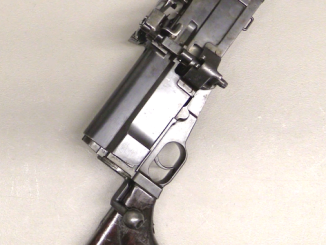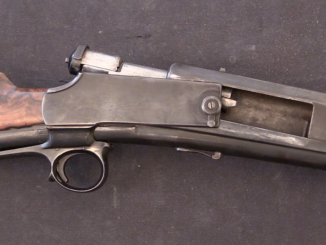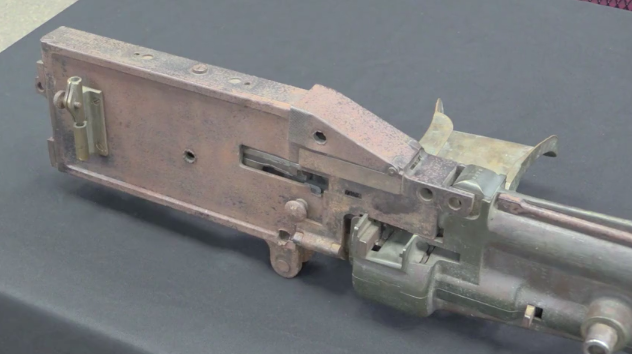The Gaulois (Gallic) was a compact squeeze-type palm pistol made by the Manufrance concern in St. Etienne in the 1890s. It held 5 rounds of 8mm ammunition (similar to the .32 Extra-Short used in other types of palm pistols) and was fired by squeezing the rear grip into the body of the gun.
As with the other weapons of this type that achieved some popularity in the 1880s through early 1900s, the Gaulois eventually faded from the market because of the improvements in conventional handguns. Something like a compact Iver Johnson revolver offered all the capabilities (if not more) of a Chicago Protector or My Friend or Gaulois, without the loading and aiming difficulties of those designs.




Bicycles were really cool back then, having one was a status symbol. Thats why they printed cicle on the gun. In those days you could get a little Velodog pistol as a bonus when you bought a bicycle, like we get a a cheap MTB from china today when we buy a new dishwasher. I’d rather have a crappy little pistol than a dangerous bike.
I think that manual repeating pistol fall into oblivion due to introduction of automatic pistol. The manual repeating pistol were more slim that revolver simply because they don’t have cylinder, so were easier to carry. The weak (from today standpoint of view) ammunition was not considered as a flaw – notice the popularity of .25 Auto pistols in early 20th century.
Do you know when the FRANCOTTE repeating pistol – link: http://www.manebooks.com/firearms/francotte.htm – was produced. I wonder: is it form borrowed from automatic pistols or it was invented independent?
The manual repeaters, ranging from the compact Gaulois and Tribuzio to the full-sized Bittner “parlor pistols”, were the direct ancestors of the blowback self-loaders. Give the Gaulois a recoil spring instead of the holdback springs and a proper trigger, and it would be a self-loader.
Also, Manufrance’s later line of “Le Francais” self-loaders closely followed the layout of the Gaulois, except having their magazines in the pistol grip;
http://en.wikipedia.org/wiki/Le_Fran%C3%A7ais_%28pistol%29
The “Modele a Poche” in .25 ACP was especially close to it in size.
cheers
eon
I suspect that the “disassembly mode” selector had something to do with removing the rear squeeze actuator and breech block from the pistol. It pulls the safety bar down completely out of the way of the breech block and striker. It’s hard to say just what it does though without actually trying to take it all apart. Perhaps the safety bar has to be pulled clear of the far side ejector?
The thing I find really striking though is that there appears to be no breech locking mechanism. Yet when the pistol fires, your hand is pushing directly on the back of the breech block. Either this gives your hand a “kick” when it fires (via blow-back), or there is more going on inside than meets the eye.
I also have noticed the lockless breechbolt action. But the round is so weak and the recoil spreading surface is so large. The gun will behave in the grasped hand against to the recoil nearly same as a similar caliber revolver. What really looking fiddy is magazine loading. Cartridges may spread around if located incorrectly.
Axel, it is not because bicycles were a status symbol that “cycle” was written on the gun.
“Manufacture d’armes et cycles de Saint Etienne” means “manufacture of guns and cycles of Saint Etienne” : it was the real name of Manufrance. Indeed, it is normal that the word “cycles” appears on the gun : the company wrote its entiere name. It is absolutely not for “cool” or “social status” reason.
Moreover, having a bicycle in France in 1890’s – 1900’s was not a symbol of social status. It was the mean of locomotion of people living in rural places (either rich or poor people). Nothing more, nothing else. Everybody had a bicycle, even kids. In 1891, the bicycle had the shape it has nowadays and less than few years later it was common all over France.
Neither was the “velodog” a bonus for buying a bike : it was a need. In France during this time, many wild animals, especially dogs and sometime other animal (like european wildcats, which seem to be peacefull cute creatures but are capable of killing a red deer – which they commonly eat, hence their nickname “loup cervier”, litterally “red deer’s wolf”), were likely to attack people on the road, especially if they were rabic (I don’t know if it is correct… I mean “which have rabies illness”).
As a result, bicycles were sold with a gun to protect the biker in the rural roads. Those guns were the so called “velodog”, which means “[gun for] bicycle [to defend against] dogs”.
Manufrance, which was a bicycles manufacture, made firearms (which was absolutely normal at this time : even local and small workshops with no connection to firearms manufactured guns from time to time) to give with the bicycle (as all other french bicycles manufacturers of the time), not as a “bonus” but as a mean of personnal defense.
Their gun began to be widespread and their exceptionnal quality made Manufrance recognized for its guns, which then began to be their principal source of income.
In 1999, one year before the collapse of Manufrance, there was still written “cycles” on their guns… And i’m sure you agree bicycles were not a symbol of social status in 1999.
Eon, be carefull : the “Le Français” is an original design which is not comparable with the “Le Gaulois”. Their mechanism is absolutely not the same.
I know. I was comparing role and size, not necessarily mechanism. But if you check Ezell’s Handguns of the World, he points out the parallels between late manual repeaters and early self-loaders.
BTW, the correct term is “rabid”.
😉
cheers
eon
Indeed, they are quite similar on this two points
I will try to find this book (it’s quite hard in France, which has a limited number of weapons related publishing because of politicaly correct statements, hence very few foreign books are available and we are limited to national publishing).
Thank you for the correction !
In this period bicycles had a totally different social status than what they have today. Even in the USA bicycle racing was a big spectator sport (Charles Minthorn Murphy ‘a mile a minute’ is from this era). Having a bicycle was indeed common, but definitely modern and cool. And there is no doubt in my mind they put cycle on the gun to make ppl identify them with this modern way of transport. That is what I mean with status.
I have seen ads of bikes that included Velodog guns. Of course ppl bought them separately as well.
As I explained, bicycles in France in the 1890’s were not “cool” nor anything else (in fact it was a substitute for the horse, which was really considered cool but was too expensive for most people). And it is not because in USA they had this symbol that it was the case in other countries.
In the 1890’s USA, bike were with no doubt cool and a symbol of modernity which showed other people that you had a respectable social status (as you said) but in France, it just showed you were like anybody else : too poor to have a horse drawn carriage or even just a horse, and were using the normal way of transport of the time.
Is it necessary to remind that the “byciclette”, the first practical modern bicycle, was French and that it was very common for everybody in the country as soon as 1875 ? So twenty years after… It wasn’t modern at all for the people of my country. Even if it still was in USA.
It is a common and annoying error american people frequently do when they talk to european : “it was ### even in the USA so in your country it was at best the case too, even if I don’t know anything about your country”. No. I’m sorry, no. USA is not a benchmark from which everything is measured. USA is a country, like any other country. And as with any other country, it happens that something has a meaning in USA that it has not in other countries, because USA is not a reference model that every country in the world try to copy. USA is surely a beautiful and great country. I admire some of USA’s particularities my country doesn’t have, like the way the government show confidence in its people (or at least it semms to be, seen from outside), which is really beautiful. But it doesn’t means that USA is better on all counts, nor it is a standard on which everything is based.
I am French, I know the history of my country (including its most famous companies), I am a weapon connoisseur which I study (including my country’s companie’s ones) and I know the laws of my countries because I studied it in faculty (including the older ones, especially about firearms). Now, I tell you the word “cycles” was written for the sole reason it is the name of the company who produces the gun. It is a law in France (and I think it is the case about everywhere else) : when producing a gun, a company must write its name on it. Do not try to tell me “you are wrong. I don’t know anything about your country but I decided you are wrong so you are wrong”. No, I’m not.
And as I already said, guns produced in the late 1990’s during the last days of Manufrance still had “cycles” written on it, which is a proof it was not written for “cool” or “social status” nor for advertising porpose because in late 1990’s bicycles were not symbol of social status. As it was already not in the 1890’s.
I am not American.
Bicycles were not really a substitute for the horse in Europe. A horse was a gentleman’s mode of transport in in Europe. Before the bicycle ppl walked or took a tram. The introduction of the bicycle had a profound impact on human history, as much then as the internet have today. Thanks to the bike, people could take a job in town, or travel to a political meeting. There are tons of scholarly papers on the bicycles impact on political life in the pre WW 1 era.
Wikipedia: “The bicycle was recognized by 19th-century feminists and suffragists as a “freedom machine” for women. American Susan B. Anthony said in a New York World interview on February 2, 1896: “I think it has done more to emancipate woman than any one thing in the world.”
And it was the fastest thing ordinary people then had owned. The bicycle have never had a higher status than in France. At this time, velodrome racing was a big spectator sport. And soon TDF became a fact (since 1903).
Generally in is agreed that H J Lawson is the inventor of the then so called ‘Safety Bicycle’. This was in 1880, he called it “Bicyclette” presented at a trade show that year. By this is meant a bike that does not put the rider in a very elevated position. It had chain drive to the back wheel, but looked odd compared to a modern bike, I have not seen a picture of it.
http://en.wikipedia.org/wiki/Safety_bicycle
To find a bicycle that a modern rider would find recognizable one would have to wait until the late 1880’s, and the British firm Humber is credited as the inventor. in 1888 the pneumatic tire was introduced by Dunlop, that was probably the most important intervention as far as comfort and speed goes (less important for highwheelers). In 1898 the British Reynold company patented the ‘Butted Tube’ technology, making the frame much lighter and more flexible. Freewheels were already invented in the highwheeler era (and was used in other applications far earlier), but were not always standard on bikes even in the early 1900’s. As you can see back then Britain was the workshop of the world!
The 1890 was an era when bicycles became much faster. They were considered speed machines, and speeding tickets were handed out.
http://en.wikipedia.org/wiki/Bike_boom
Excuse me, I do not find any interest in talking with someone that had decided what he thinks is inevitably true even if he doesn’t know what he is talking about.
I told you everything I could to make you understand, you could check out, you could trust me because I surely know far more about my own country than a foreigner, but you don’t. You don’t because you have decided you were right even if what you tell is not what you know, but what you think. I can’t do anything for you. I’m really sorry, in fact, and it inspires me sadness and consternation.
So, if it may help you feel better, after all, yes, Manufrance written “cycles” on this gun to make it cool and modern, even if cycles were not cool nor modern in France in 1890’s, and it has absolutely nothing to do with the name of the company, which also contains totally by accident the word “cycles”, company which is totally by accident obliged to mark its name on the gun they produce by French laws. Totally by accident, because if it marked “cycles” on the gun, it was neither for legal reason nor because it is its name, but because for cool and modern reason, as you arbitrarily decided. It must be a pleasant feeling to change history and facts by your simple wishes, I admire your power.
Farewell sir, there are many people and topics worthy of my time and interest that await me.
By the way, your pronunciation is quite good 😉
careful though : we say “D’Armes” and not “DE-armes” and “francaiSE” (“manufacture” is a feminine word in french so the adjective “français” is told as a feminine : pronounce “FrançaiZ”)
But i’m magnanimous and I forgive you for this time ;p
I appreciate it. 🙂
Hi Ian. I know you’ve done this video long ago and probably you’ve answered the remaining questions you’ve had about this gun but I will make some amends nevertheless.
I’ve just got a working No.1 and realized that the “D” position of the safety button also allows the user to eject all the rounds from the magazine, as the extractor still works, whilst the firing pin is disconnected.
Also in your film, the plate of the magazine (the piece on top of the spring) is placed wrong the way around. It should be turned around 180 degrees so the slope will come down from the barrel towards the grip, to allow the feeding.
I hope this helps.
Best regards and appreciation for your work,
Razvan Ionascu
Historian,
The Antiques Storehouse
Portsmouth Historic Dockyard UK